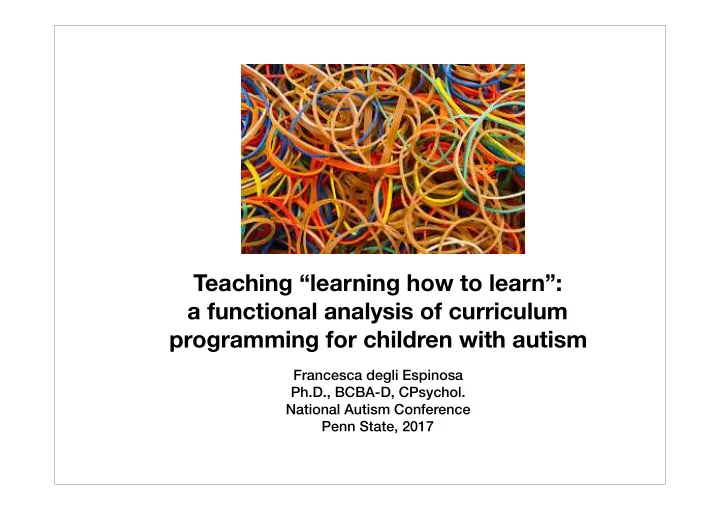

Teaching “learning how to learn”: a functional analysis of curriculum programming for children with autism Francesca degli Espinosa Ph.D., BCBA-D, CPsychol. National Autism Conference Penn State, 2017
Topics • Curriculum development: historical and theoretical underpinnings • Curricula in behavioural intervention for children with autism: a structural analysis • Curriculum development in behavioural intervention: a functional analysis • Defining skills: generalised vs cumulative • Discriminative learning: simple vs conditional in early learners • The speaker as its own listener: naming
What is education? Skinner (1964, p.484)
To run • From the Latin word for the “course of a race”, originally derived from “currere”, to run. • “All the learning which is planned and guided by [a] school, whether it is carried on in groups or individually, inside or outside the school” (Kelly, 1983, p. 10). • ABA and autism: to accelerate learning and modify developmental trajectory
Evolution of curriculum development theory • Curriculum as transmission of knowledge and as a product: sequence of objectives, definition and measurement of attainment (Tyler, 1949) • Curriculum as a process (Stonehouse, 1974): not a syllabus to be followed, but a proposal to be tested. Emphasis on empiricism: selecting content, developing teaching strategies, sequencing learning experiences, and assessing student strengths and weaknesses with an emphasis on empiricism. • Curriculum as a praxis: a commitment to curriculum development and the context in which it is implemented. Emphasises curriculum as a social process marked by the interactions within the learning environment and the concept of “assisted performance” (Wildman, 2007) or Vygotskian scaffolding.
History of curricula in EIBI
Since then…
‘That is, the curriculum is not simply a set of plans to be implemented, but rather is constituted through an active process in which planning, acting and evaluating are all reciprocally related and integrated into the process’ Grundy (1987, p.115)
Tyler, 1949 1. What educational purposes should the school seek to attain? 2. What educational experiences can be provided that are likely to attain these purposes? 3. How can these educational experiences be effectively organised? 4. How can we determine whether these purposes are being attained?
A structural analysis 1. Clear definition of learning objectives. 2. Descriptions of teaching procedures for acquisition and generalisation. 3. Sequential organisation of learning objectives within and across curricular domains. 4. Data-based evaluation of mastery and generalisation of learning outcomes.
General organisation of all curricula • Curricular domains • Programme or task • Items or responses • Mastery criteria
“Since the real purpose of education is not to have the instructor perform certain activities but to bring about significant changes in the students' pattern of behaviour, it becomes important to recognize that any statement of objectives […] should be a statement of changes to take place in the students” Tyler (1949, p. 44).
A shift in stimulus control for curriculum design • Behavioural curricula have been almost exclusively concerned with the nature and structure of curriculum content • Need for transition to the design and arrangement of teaching procedures that will ensure the greatest gains in novel, untaught, skills from the minimum amount of direct teaching • Learning how to learn: a common goal for all educators
“Learning should not only take us somewhere; it should allow us to go further more easily… The more fundamental the idea, the greater will be its breath of applicability to new problems” (Bruner, 1960, p.17-18)
A functional analysis • Understanding the type and function of the skill • Understanding stimulus control for that skill • A framework for understanding skills regardless of manual or theoretical orientation
Interpretative framework • Curriculum as a syllabus vs curriculum as a process • How vs what
Tasks and items • A task, a programme, an activity: an arrangement of teaching contingencies to facilitate the development of a skill • Item: the specific stimulus (e.g., visual or auditory) to which responding is established within that task
Skills and responses • Skill: a change in stimulus control of selected stimuli over a response class, the establishment of which is demonstrated by specific topographies • Skill: a class of responses. • Target response: a specific topography contingent on the presentation of specific stimuli
Mastery criteria • When is a target topography or • When is a skill mastered? response mastered? • If accurate performance is • When it is performed without displayed to all stimuli in the prompts on a specific criterion set? (e.g., a probe trial over 3 consecutive days)? • If performance occurs outside the teaching context? • But what kind of a response is it? What kind of discrimination? • If the child demonstrates a response not previously taught? • When the skill is generalised? How do we define generalisation of a skill?
Defining skills • Generalised skills • Finite or cumulative skills • At least one teaching trial • More than one novel (one instance of response (no direct teaching) reinforcement) is required to can be established as a establish any novel response result of teaching individual within that skill. responses within the same class • Example: receptive labelling. • Example: motor imitation, visual-visual match to sample, naming, descriptions, recalling past events
Cumulative skills • Limited number of items • Unlimited number of items • Speed of acquisition, the • A specific number of items. minimum number of trials to demonstrate errorless • Example: prepositions, discriminative responding possessive pronouns (i.e., three) • Transfer across operants (e.g., listener to tact/ naming, tact to intraverbal control)
Recommend
More recommend